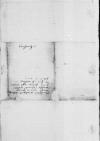Letter #784
Ioannes CAMPENSIS (Jan van CAMPEN) to Ioannes DANTISCUSNuremberg, 1532-05-04
Manuscript sources:
Auxiliary sources:
Prints:
| ||||||||||||||||||||||||||
Text & apparatus & commentary Plain text Text & commentary Text & apparatus
Eruditione et reliquis dotibus clarissimo viro, domino
Absolvitur iam nunc tandem, quod reliquum fuerat Psalmorum paraphrasis.
Nos
Vera esse, quae scribo vel illinc colligere tibi licebit, quod in nuperrimis, quas ad te scripsi, cf.
Vale, vir amplissime.
Tuus modis omnibus


 UUB, H. 154, f. 85v
UUB, H. 154, f. 85v